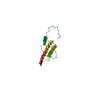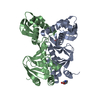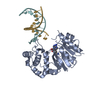+ Open data
Open data
- Basic information
Basic information
| Entry | Database: PDB / ID: 5yj4 | ||||||
|---|---|---|---|---|---|---|---|
| Title | structure for the protective mutant G127V of Human prion protein | ||||||
 Components Components | Major prion protein | ||||||
 Keywords Keywords |  MEMBRANE PROTEIN / Prion disease / G127V mutant / disease-resistance MEMBRANE PROTEIN / Prion disease / G127V mutant / disease-resistance | ||||||
| Function / homology |  Function and homology information Function and homology informationpositive regulation of glutamate receptor signaling pathway / negative regulation of amyloid precursor protein catabolic process /  lamin binding / regulation of glutamate receptor signaling pathway / regulation of calcium ion import across plasma membrane / aspartic-type endopeptidase inhibitor activity / lamin binding / regulation of glutamate receptor signaling pathway / regulation of calcium ion import across plasma membrane / aspartic-type endopeptidase inhibitor activity /  glycosaminoglycan binding / ATP-dependent protein binding / regulation of potassium ion transmembrane transport / NCAM1 interactions ...positive regulation of glutamate receptor signaling pathway / negative regulation of amyloid precursor protein catabolic process / glycosaminoglycan binding / ATP-dependent protein binding / regulation of potassium ion transmembrane transport / NCAM1 interactions ...positive regulation of glutamate receptor signaling pathway / negative regulation of amyloid precursor protein catabolic process /  lamin binding / regulation of glutamate receptor signaling pathway / regulation of calcium ion import across plasma membrane / aspartic-type endopeptidase inhibitor activity / lamin binding / regulation of glutamate receptor signaling pathway / regulation of calcium ion import across plasma membrane / aspartic-type endopeptidase inhibitor activity /  glycosaminoglycan binding / ATP-dependent protein binding / regulation of potassium ion transmembrane transport / NCAM1 interactions / negative regulation of interleukin-17 production / negative regulation of dendritic spine maintenance / type 5 metabotropic glutamate receptor binding / cupric ion binding / negative regulation of protein processing / negative regulation of calcineurin-NFAT signaling cascade / glycosaminoglycan binding / ATP-dependent protein binding / regulation of potassium ion transmembrane transport / NCAM1 interactions / negative regulation of interleukin-17 production / negative regulation of dendritic spine maintenance / type 5 metabotropic glutamate receptor binding / cupric ion binding / negative regulation of protein processing / negative regulation of calcineurin-NFAT signaling cascade /  dendritic spine maintenance / negative regulation of interleukin-2 production / negative regulation of T cell receptor signaling pathway / Insertion of tail-anchored proteins into the endoplasmic reticulum membrane / dendritic spine maintenance / negative regulation of interleukin-2 production / negative regulation of T cell receptor signaling pathway / Insertion of tail-anchored proteins into the endoplasmic reticulum membrane /  extrinsic component of membrane / cuprous ion binding / negative regulation of amyloid-beta formation / negative regulation of activated T cell proliferation / response to amyloid-beta / : / negative regulation of type II interferon production / intracellular copper ion homeostasis / negative regulation of long-term synaptic potentiation / positive regulation of protein targeting to membrane / extrinsic component of membrane / cuprous ion binding / negative regulation of amyloid-beta formation / negative regulation of activated T cell proliferation / response to amyloid-beta / : / negative regulation of type II interferon production / intracellular copper ion homeostasis / negative regulation of long-term synaptic potentiation / positive regulation of protein targeting to membrane /  long-term memory / response to cadmium ion / regulation of peptidyl-tyrosine phosphorylation / long-term memory / response to cadmium ion / regulation of peptidyl-tyrosine phosphorylation /  inclusion body / cellular response to copper ion / neuron projection maintenance / inclusion body / cellular response to copper ion / neuron projection maintenance /  tubulin binding / negative regulation of protein phosphorylation / molecular condensate scaffold activity / molecular function activator activity / positive regulation of protein localization to plasma membrane / protein destabilization / protein homooligomerization / negative regulation of DNA-binding transcription factor activity / tubulin binding / negative regulation of protein phosphorylation / molecular condensate scaffold activity / molecular function activator activity / positive regulation of protein localization to plasma membrane / protein destabilization / protein homooligomerization / negative regulation of DNA-binding transcription factor activity /  terminal bouton / cellular response to amyloid-beta / positive regulation of peptidyl-tyrosine phosphorylation / positive regulation of neuron apoptotic process / cellular response to xenobiotic stimulus / terminal bouton / cellular response to amyloid-beta / positive regulation of peptidyl-tyrosine phosphorylation / positive regulation of neuron apoptotic process / cellular response to xenobiotic stimulus /  signaling receptor activity / signaling receptor activity /  amyloid-beta binding / protein-folding chaperone binding / postsynapse / amyloid-beta binding / protein-folding chaperone binding / postsynapse /  microtubule binding / microtubule binding /  nuclear membrane / nuclear membrane /  protease binding / response to oxidative stress / transmembrane transporter binding / protease binding / response to oxidative stress / transmembrane transporter binding /  postsynaptic density / molecular adaptor activity / learning or memory / postsynaptic density / molecular adaptor activity / learning or memory /  regulation of cell cycle / regulation of cell cycle /  membrane raft / copper ion binding / membrane raft / copper ion binding /  cell cycle / external side of plasma membrane / intracellular membrane-bounded organelle / cell cycle / external side of plasma membrane / intracellular membrane-bounded organelle /  dendrite / protein-containing complex binding / negative regulation of apoptotic process / dendrite / protein-containing complex binding / negative regulation of apoptotic process /  Golgi apparatus / Golgi apparatus /  cell surface / cell surface /  endoplasmic reticulum / extracellular exosome / identical protein binding / endoplasmic reticulum / extracellular exosome / identical protein binding /  plasma membrane / plasma membrane /  cytosol / cytosol /  cytoplasm cytoplasmSimilarity search - Function | ||||||
| Biological species |   Homo sapiens (human) Homo sapiens (human) | ||||||
| Method |  SOLUTION NMR / SOLUTION NMR /  simulated annealing simulated annealing | ||||||
 Authors Authors | Zheng, Z. / Lin, D. | ||||||
 Citation Citation |  Journal: Sci Rep / Year: 2018 Journal: Sci Rep / Year: 2018Title: Structural basis for the complete resistance of the human prion protein mutant G127V to prion disease. Authors: Zheng, Z. / Zhang, M. / Wang, Y. / Ma, R. / Guo, C. / Feng, L. / Wu, J. / Yao, H. / Lin, D. | ||||||
| History |
|
- Structure visualization
Structure visualization
| Structure viewer | Molecule:  Molmil Molmil Jmol/JSmol Jmol/JSmol |
|---|
- Downloads & links
Downloads & links
- Download
Download
| PDBx/mmCIF format |  5yj4.cif.gz 5yj4.cif.gz | 863.2 KB | Display |  PDBx/mmCIF format PDBx/mmCIF format |
|---|---|---|---|---|
| PDB format |  pdb5yj4.ent.gz pdb5yj4.ent.gz | 729.4 KB | Display |  PDB format PDB format |
| PDBx/mmJSON format |  5yj4.json.gz 5yj4.json.gz | Tree view |  PDBx/mmJSON format PDBx/mmJSON format | |
| Others |  Other downloads Other downloads |
-Validation report
| Arichive directory |  https://data.pdbj.org/pub/pdb/validation_reports/yj/5yj4 https://data.pdbj.org/pub/pdb/validation_reports/yj/5yj4 ftp://data.pdbj.org/pub/pdb/validation_reports/yj/5yj4 ftp://data.pdbj.org/pub/pdb/validation_reports/yj/5yj4 | HTTPS FTP |
|---|
-Related structure data
| Related structure data |  5yj5C C: citing same article ( |
|---|---|
| Similar structure data | |
| Other databases |
|
- Links
Links
- Assembly
Assembly
| Deposited unit | 
| |||||||||
|---|---|---|---|---|---|---|---|---|---|---|
| 1 |
| |||||||||
| NMR ensembles |
|
- Components
Components
| #1: Protein | Mass: 16285.220 Da / Num. of mol.: 1 / Fragment: UNP residues 91-231 Source method: isolated from a genetically manipulated source Source: (gene. exp.)   Homo sapiens (human) / Gene: PRNP, ALTPRP, PRIP, PRP Homo sapiens (human) / Gene: PRNP, ALTPRP, PRIP, PRPProduction host: References: UniProt: P04156 |
|---|
-Experimental details
-Experiment
| Experiment | Method:  SOLUTION NMR SOLUTION NMR | ||||||||||||||||||||||||||||||||||||||||||||||||||||||||||||||||||||||||||||||||||||
|---|---|---|---|---|---|---|---|---|---|---|---|---|---|---|---|---|---|---|---|---|---|---|---|---|---|---|---|---|---|---|---|---|---|---|---|---|---|---|---|---|---|---|---|---|---|---|---|---|---|---|---|---|---|---|---|---|---|---|---|---|---|---|---|---|---|---|---|---|---|---|---|---|---|---|---|---|---|---|---|---|---|---|---|---|---|
| NMR experiment |
|
- Sample preparation
Sample preparation
| Details | Type: solution Contents: 0.5 mM [U-99% 13C; U-99% 15N] HuPrP(G127V), 90% H2O/10% D2O Label: 13C/15N_sample / Solvent system: 90% H2O/10% D2O |
|---|---|
| Sample | Conc.: 0.5 mM / Component: HuPrP(G127V) / Isotopic labeling: [U-99% 13C; U-99% 15N] |
| Sample conditions | Ionic strength: 20 mM / Label: nmrbuffer / pH: 4.5 / Pressure: 1 atm / Temperature: 298 K |
-NMR measurement
| NMR spectrometer | Type: Bruker AVANCE III / Manufacturer: Bruker / Model : AVANCE III / Field strength: 850 MHz : AVANCE III / Field strength: 850 MHz |
|---|
- Processing
Processing
| NMR software |
| |||||||||||||||
|---|---|---|---|---|---|---|---|---|---|---|---|---|---|---|---|---|
| Refinement | Method:  simulated annealing / Software ordinal: 3 simulated annealing / Software ordinal: 3 Details: 2841 are NOE-derived distance constraints, 168 dihedral angle restraints | |||||||||||||||
| NMR representative | Selection criteria: lowest energy | |||||||||||||||
| NMR ensemble | Conformer selection criteria: structures with the lowest energy Conformers calculated total number: 500 / Conformers submitted total number: 20 |
 Movie
Movie Controller
Controller











 PDBj
PDBj


